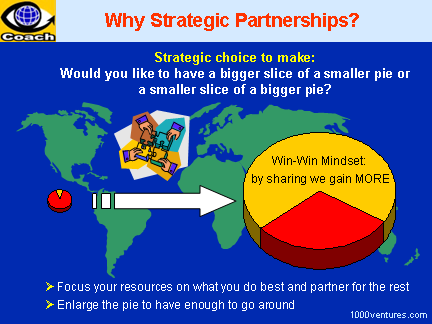| |
|
Benefits of
Business
Partnerships
|
|
|
 |
Synergize
core competencies, competitive
advantages, complementary resources and
distinctive capabilities |
 VadiK
VadiK |
|
Inventor
Author
Founder |
 |
|
Synergy is the power behind business partnerships.
In a business partnership,
two parties leverage their assets (core competencies,
competitive advantages, resources,
capabilities, expertise, client base etc.) for the
mutual benefit of both. |
|
|
|
|
The
80/20 Principle asserts that 80% of results come
from 20% of effort.
Thus, to achieve more with less, you
must be selective, not exhaustive.
In every important
sphere, work out where 20% of effort can lead to 80% of
returns.
Strive for excellence in the few key areas,
rather than for good performance in many. |
|
|
|
|
Barriers between
companies, which used to be solid and absolute, are now
permeable. "Iconoclasm and creativity are now the keys
to success", writes Mark Stevens, the author of
Extreme Management. "For generations companies built
moats between themselves and their competitors. Today
the most successful companies build bridges. And that's
only the beginning".
Virtual integration became a norm. |
|
| |
|
Not all partnerships are created
for a good cause unfortunately
The captured alive Ukrainian
terrorists who blew up passenger
trains in Russia honestly
admitted that they were trained
in Lithuania, Estonia and
Norway (yes, Norway, the country
that awards the
Nobel Peace
Prize). The training was
conducted by instructors from
Canada and Great Britain. The
explosives used were Czech...
More info
|
|
|
|
|